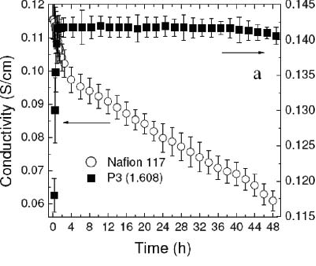
Proton conductivity results from NafionTM 117 and one of Berkeley Lab’s polymers as a function of time at T= 90oC and relative humidity of 98%. (For more data comparing the performance of the Berkeley Lab membranes to that of NafionTM please see the Nano Letters publication.
APPLICATIONS OF TECHNOLOGY:
- PEM fuel cells for transportation and portable electronic devices (e.g., laptop, mp3 players, cell phones)
- Clothing that protects from dehydration
ADVANTAGES:
- Retains more water at higher temperatures than at lower temperatures, at constant relative humidity
- Operates at a higher temperature (90°C) and lower humidity (50%) than conventional PEMs
- Provides more consistent performance at high temperatures than conventional membranes
DESCRIPTION:
While polymer electrolyte membrane (PEM) fuel cells offer promising power alternatives, the performance of current state-of-the-art PEMs is hindered by water loss when operating at temperatures greater than 60°C, and under low humidity (relative humidity of about 50%). This is a disadvantage, because proton conductivity, which is essential for a functioning fuel cell, is directly related to the ability of the PEM to retain water. Although low temperatures and high humidity are the ideal conditions for operating a fuel cell, they are often not feasible due to limitations from catalytic activities, side reactions, and costs associated with humidification and heat removal.
To meet this need, Nitash Balsara and Moon Jeong Park of Berkeley Lab have created novel nanostructured polymer electrolyte membranes (PEMs) that exhibit relatively large values for proton conductivity at high temperature (90°C) and low humidity (50%). The results are due to the surprising fact that the Berkeley Lab polymers retain more water at higher temperatures than they do at lower temperatures, given constant relative humidity.
Berkeley Lab PEMs retain increased amounts of water at elevated temperatures due to nanostructured hydrophilic channels formed by self-assembly of polystyrenesulfonate-block-polymethylbutylene (PSS-b-PMB) block copolymers. The channels have well-defined widths in the 2.5 to 5 nm range, much smaller than those of conventional membranes. Simple calculations show that capillary condensation effects are significant at these length scales. Berkeley Lab’s Nanostructured PEMs are the first materials to demonstrate the impact of these effects on proton conductivity in nanoscale channels. Other effects, such as the increase in the entropy of water molecules due to confinement within small features, may also play an important role in the Berkeley Lab PEMs’ higher water retention and higher operating temperatures.
Because PSS-b-PMB block copolymers are thermally stable up to 150°C, the Berkeley Lab PEMs have the potential to increase the operating temperature of fuel cells for transportation and microelectronics. The polymer membranes may also serve other applications where water retention is important, such as in the manufacturing of protective clothing for desert environments.

(a) Water uptake results from PSS-PMBs as a function of temperature at RH = 98%. P1, P3 and P4 are low molecular weight PSS block polymers with hydrophilic channels < 5 nm. P5, P9 and P48 are higher molecular weight PSS block polymers with larger hydrophilic channels.
STATUS:
- Published PCT Patent Application WO2009/011753 available at www.wipo.int. Available for licensing or collaborative research.
To learn more about licensing a technology from LBNL see here.
FOR MORE INFORMATION:
REFERENCE NUMBER: IB-2416
SEE THESE OTHER BERKELEY LAB TECHNOLOGIES IN THIS FIELD: